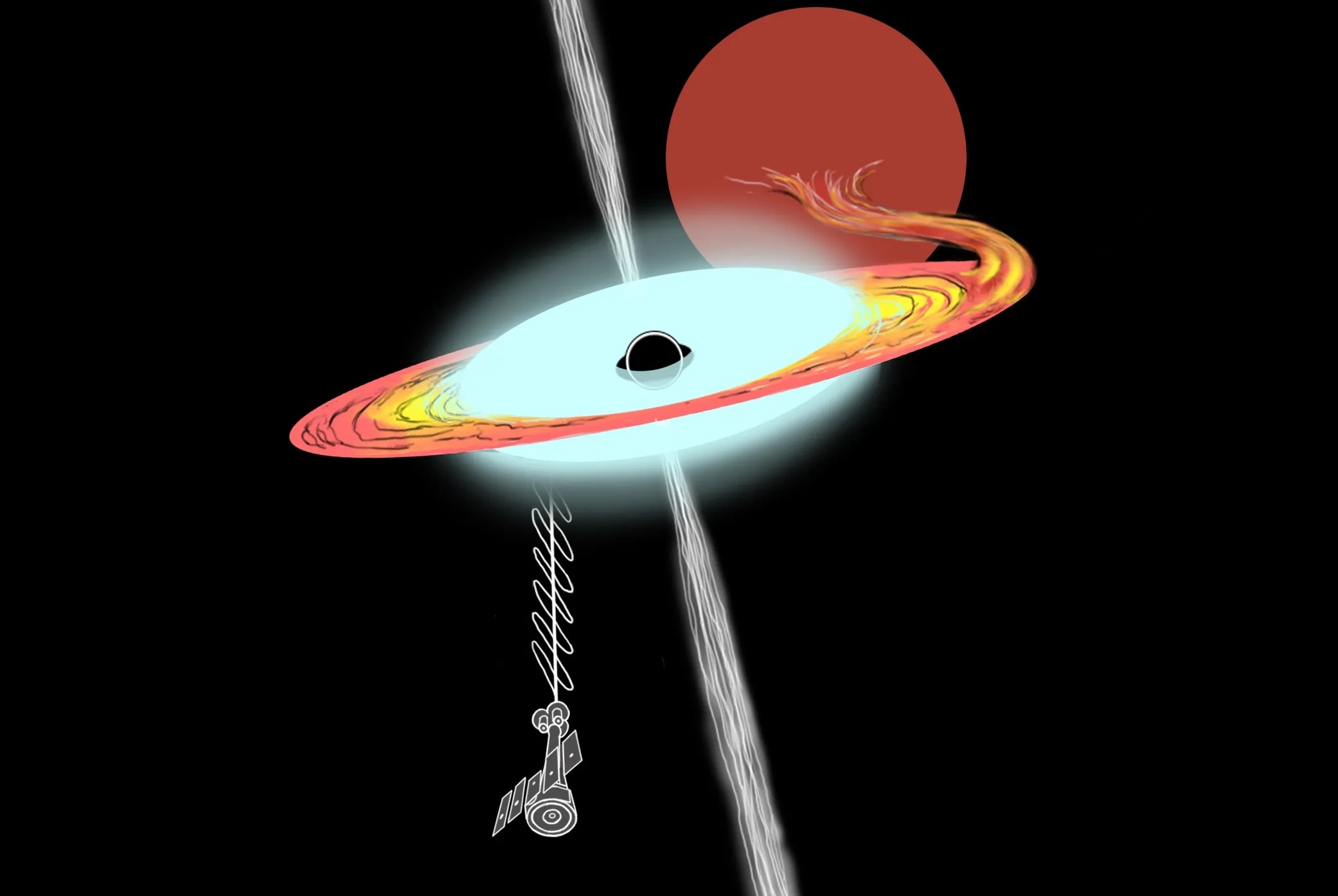8.12.2024
NASA’s IXPE (Imaging X-ray Polarimetry Explorer) has helped astronomers better understand the shapes of structures essential to a black hole – specifically, the disk of material swirling around it, and the shifting plasma region called the corona.
The stellar-mass black hole, part of the binary system Swift J1727.8-1613, was discovered in the summer of 2023 during an unusual brightening event that briefly caused it to outshine nearly all other X-ray sources. It is the first of its kind to be observed by IXPE as it goes through the start, peak, and conclusion of an X-ray outburst like this.

Swift J1727 is the subject of a series of new studies published in The Astrophysical Journal and Astronomy & Astrophysics. Scientists say the findings provide new insight into the behavior and evolution of black hole X-ray binary systems.
“This outburst evolved incredibly quickly,” said astrophysicist Alexandra Veledina, a permanent researcher at the University of Turku, Finland. “From our first detection of the outburst, it took Swift J1727 just days to peak. By then, IXPE and numerous other telescopes and instruments were already collecting data. It was exhilarating to observe the outburst all the way through its return to inactivity.”
Until late 2023, Swift J1727 briefly remained brighter than the Crab Nebula, the standard X-ray “candle” used to provide a baseline for units of X-ray brightness. Such outbursts are not unusual among binary star systems, but rarely do they occur so brightly and so close to home – just 8,800 light years from Earth. The binary system was named in honor of the Swift Gamma-ray Burst Mission which initially detected the outburst with its Burst Alert Telescope on Aug. 24, 2023, resulting in the discovery of the black hole.
X-ray binary systems typically include two close-proximity stars at different stages of their lifecycle. When the elder star runs out of fuel, it explodes in a supernova, leaving behind a neutron star, white dwarf, or black hole. In the case of Swift J1727, the powerful gravity of the resulting black hole stripped material from its companion star, heating the material to more than 1.8 million degrees Fahrenheit and producing a vast outpouring of X-rays. This matter formed an accretion disk and can include a superheated corona. At the poles of the black hole, matter also can escape from the binary system in the form of relativistic jets.
IXPE, which has helped NASA and researchers study all these phenomena, specializes in X-ray polarization, the characteristic of light that helps map the shape and structure of such ultra-powerful energy sources, illuminating their inner workings even when they’re too distant for us to see directly.
Because light itself can’t escape their gravity, we can’t see black holes. We can only observe what is happening around them and draw conclusions about the mechanisms and processes that occur there. IXPE is crucial to that work.

ALEXANDRA VELEDINA
NASA Astrophysicist
“Because light itself can’t escape their gravity, we can’t see black holes,” Veledina said. “We can only observe what is happening around them and draw conclusions about the mechanisms and processes that occur there. IXPE is crucial to that work.”
Two of the IXPE-based studies of Swift J1727, led by Veledina and Adam Ingram, a researcher at Newcastle University in Newcastle-upon-Tyne, England, focused on the first phases of the outburst. During the brief period of months when the source became exceptionally bright, the corona was the main source of observed X-ray radiation.
“IXPE documented polarization of X-ray radiation traveling along the estimated direction of the black hole jet, hence the hot plasma is extended in the accretion disk plane,” Veledina said. “Similar findings were reported in the persistent black hole binary Cygnus X-1, so this finding helps verify that the geometry is the same among short-lived eruptive systems.”
The team further monitored how polarization values changed during Swift J1727’s peak outburst. Those conclusions matched findings simultaneously obtained during studies of other energy bands of electromagnetic radiation.
A third and a fourth study, led by researchers Jiří Svoboda and Jakub Podgorný, both of the Czech Academy of Sciences in Prague, focused on X-ray polarization at the second part of the Swift J1727’s outburst and its return to a highly energetic state several months later. For Podgorný’s previous efforts using IXPE data and black hole simulations, he recently was awarded the Czech Republic’s top national prize for a Ph.D. thesis in the natural sciences.
The polarization data indicated that the geometry of the corona did not change significantly between the beginning and the end of the outburst, even though the system evolved in the meantime and the X-ray brightness dropped dramatically in the later energetic state.
The results represent a significant step forward in our understanding of the changing shapes and structures of accretion disk, corona, and related structures at black holes in general. The study also demonstrates IXPE’s value as a tool for determining how all these elements of the system are connected, as well as its potential to collaborate with other observatories to monitor sudden, dramatic changes in the cosmos.
“Further observations of matter near black holes in binary systems are needed, but the successful first observing campaign of Swift J1727.8–1613 in different states is the best start of a new chapter we could imagine,” said Michal Dovčiak, co-author of the series of papers and leader of the IXPE working group on stellar-mass black holes, who also conducts research at the Czech Academy of Sciences.
More about IXPE
IXPE, which continues to provide unprecedented data enabling groundbreaking discoveries about celestial objects across the universe, is a joint NASA and Italian Space Agency mission with partners and science collaborators in 12 countries. IXPE is led by NASA’s Marshall Space Flight Center in Huntsville, Alabama. Ball Aerospace, headquartered in Broomfield, Colorado, manages spacecraft operations together with the University of Colorado’s Laboratory for Atmospheric and Space Physics in Boulder.
Quelle: NASA
